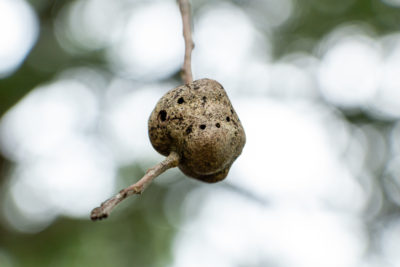Small Wasps Cause Oak Gall
 This twig disease has been historically disregarded as a cosmetic tree problem. Large growths develop on the stems of oak trees and cut off the flow of nutrients out to the tip of the twig. Oak trees have so many branches that a few galls do not affect the overall health of the tree. However, in recent years this gall has become more prolific, and if an infestation is severe, the entire tree can be killed.
This twig disease has been historically disregarded as a cosmetic tree problem. Large growths develop on the stems of oak trees and cut off the flow of nutrients out to the tip of the twig. Oak trees have so many branches that a few galls do not affect the overall health of the tree. However, in recent years this gall has become more prolific, and if an infestation is severe, the entire tree can be killed.
What Trees & Shrubs Are Affected By Oak Gall?
As the name suggests, gouty oak gall affects the oak species. The following oaks are particularly susceptible without care:
- Oak trees in the red oak group
- Pin Oak
- Shingle Oak
- Red Oak
- Black Oak
What Is The Lifecycle Of Oak Gall?
The insect has a complex three year life cycle that includes egg laying and invasion of the leaves and twigs. The leaf damage is minimal, but the twig damage results in the large golf ball sized galls that can kill the twig and branches. Early infection stages include only a few twig galls in the tree. As more and more lifecycles of wasps re-infect the leaves and twigs, areas of the tree can be completely covered with gall formations. Wasps do not tend to travel far from the host tree. Infestation usually occurs on one tree and slowly spreads to adjacent trees.
What Are The Symptoms Of Oak Gall?
- The wound associate with the wasp causes the tree to form woody masses around twigs and branches. These galls vary in size but average about 2″ in diameter.
- Gouty oak gall is very similar to horned oak gall. However, horned oak gall has little protruding “horns” all around the woody mass.
Oak Gall Treatment Options
Due to the complex life cycle of the wasp, it is challenging to control gouty/honed oak gall. Treatment options include:
- Supporting Tree Health: If infestation is minimal, consider tolerating the galls and increasing the health and vigor of the tree. Water regularly, mulch, and consider fertilizing.
- Pruning: If possible, prune off infected branches to minimize the number of wasps emerging and prevent more injury.
- Chemical Treatment: There is a new treatment protocol that arborists are testing to see if it has good long-term results. Short-term results look promising. This treatment includes the injection of an insecticide that stays active in the tree for two years. This longevity helps to provide control at the various life stages of the wasp. It stays active within the woody parts of the tree. A second chemical is used to impact the leaf tissue and repels wasps laying eggs on the leaf surface and remains active for a couple of years. This dual treatment targets both of the major life stages of the wasp and appears to reduce the formation of new galls.
Contact Hansen’s Tree Service to schedule an assessment with an ISA-certified arborists to diagnose the problem and prescribe treatment.
